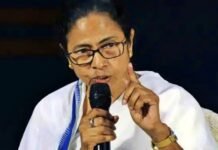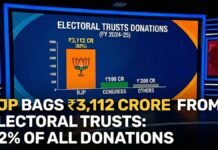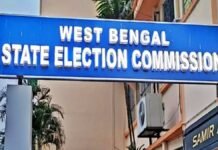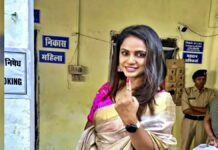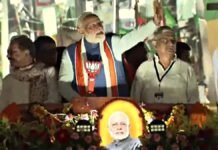
Key Points:
- Rahul alleges 25 lakh fake voters in Haryana: 5.21 lakh duplicates, 93,174 invalid addresses, 19.26 lakh “bulk voters”
- Brazilian model’s photo appears 22 times on voter rolls under different names, same photograph across multiple booths
- House #150 (BJP leader, Palwal Zila Parishad vice chairman): 66 voters registered; House #265: 500 voters registered; House #0: dozens of homeless/phantom voters
- Over 3.5 lakh voters deleted from electoral rolls, including Lok Sabha voters marked as no-show in Assembly elections
- Election Commission counters: Congress filed zero objections during voter list revision; asks if Rahul supports or opposes SIR process
- BJP’s Kiren Rijiju calls allegations “baseless,” claims Rahul uses foreign travels to collect “fake narratives”
- Haryana Chief Minister Nayab Singh Saini video: Two days before counting, claimed BJP had “system in place” to win
- Congress claims postal votes differed from actual votes for first time in Haryana history
- Priyanka Gandhi claims 65 lakh names deleted in Bihar through SIR; calls it “British Raj-like” scenario
- One voter appeared with 223 votes across two booths with identical photograph
Chandigarh: Congress leader Rahul Gandhi’s November 5 press conference at the All India Congress Committee headquarters delivered the promised “hydrogen bomb” exposé on what he termed vote chori (vote theft) an explosive allegation that nearly 1 in every 8 voters on Haryana’s electoral rolls were either duplicate registrations, non-existent individuals, or systematically manipulated entries designed to prevent Congress’s anticipated victory from translating into government formation.
Gandhi described the allegations as evidence of a state-level and potentially national-level conspiracy: “We have the ‘H-Files’ and this is about how an entire state has been stolen. We suspected that this is not happening in individual constituencies, but at the state level and at the national level,” he declared, framing the allegations as systemic electoral architecture manipulation rather than isolated irregularities.
The 25 Lakh Voter Fraud Matrix: Breaking Down the Numbers
Gandhi presented granular data allegedly documenting electoral fraud across five distinct categories:
Duplicate Voters (5.21 lakh): Multiple voter registrations for the same individual across different booths, sometimes with identical or slightly altered photographic documentation, enabling simultaneous voting at multiple locations.
Invalid Address Voters (93,174): Voter registrations with non-existent physical addresses, including “house number zero” entries officially designated for homeless populations but allegedly containing people with actual residences and fraudulent registrations.
Bulk Voters (19.26 lakh): Concentrations of voter registrations at single addresses are the most damaging category documented through Congress on-ground investigations, showing phantom addresses containing impossibly high voter densities.
Deleted Legitimate Voters: Over 3.5 lakh legitimate voters removed from electoral rolls, including individuals who had voted in Lok Sabha elections but found their names had disappeared from Assembly election rolls.
Manipulated Postal Votes: Gandhi claimed that for the first time in Haryana’s history, postal vote counts significantly diverged from physical voting center tallies, potentially indicating either fraudulent postal ballot counting or systematic mismatches between expected and actual voting patterns.
The Brazilian Model: One Woman, 22 Different Voter Identities
The centerpiece of Gandhi’s exposé involved displaying a photograph of an unidentified Brazilian model appearing 22 times on Haryana’s voter rolls under different names. Gandhi alleged that the Election Commission maintained or negligently permitted the same photograph to be used across multiple voter profiles—a technically preventable error suggesting either intentional system manipulation or gross administrative negligence.
“How can the same woman appear 22 times in the voter list?” Gandhi demanded rhetorically, arguing this scenario was statistically and logically impossible absent deliberate fraud or catastrophic system failure. The allegation transformed electoral fraud allegations from abstract statistical claims into visually compelling evidence that ordinary voters could understand—a critical strategy for mass communication impact.
House Number Anomalies: Phantom Voters and Impossible Concentrations
Gandhi presented specific cases allegedly documenting physically impossible voter concentrations at single residential addresses:
House #150 (Palwal): Registered to a BJP leader and Zila Parishad Vice Chairman, this address contained 66 registered voters. Congress investigators allegedly visited the residence and found only a single individual residing there—a discrepancy suggesting 65 fraudulently registered voters..
House #265: This address contained 500 registered voters, an impossible concentration. Congress investigators alleged they found the address either non-existent or containing far fewer residents than indicated by voter registration records.
House #0: Most damaging were “house number zero” entries. The Election Commission claims these designate homeless populations lacking fixed addresses. However, Gandhi presented evidence that Congress investigators found individuals actually residing in homes but artificially registered under house number zero, potentially facilitating systematic voter fraud through administratively invisible registrations that couldn’t be cross-verified.
Gandhi directly accused the Chief Election Commissioner of lying: “The CEC is lying to the people of India. This is not a mistake, nor is it about homeless citizens,” he asserted, escalating rhetoric from procedural criticism to allegations of deliberate deception.
The Duplicate Voter Case: 223 Votes, One Man, Identical Photo
Gandhi presented an allegation of a single individual appearing with 223 votes across two different booths, both listings displaying identical photographs. This claim suggested either photographic database cloning, deliberate voter impersonation facilitation, or systematic manipulation of identity verification systems.
Postal Vote Anomaly: The First-Time Divergence
Gandhi alleged that for the first time in Haryana electoral history, postal vote counts significantly diverged from in-person polling center results. He suggested this anomaly indicated either fraudulent postal ballot counting or systematic misalignment between expected voting patterns and actual results, a technically complex allegation that implied sophisticated electoral manipulation beyond simple duplicate registration.
The Nayab Singh Saini Video: “We Have a System in Place”
Gandhi circulated a video clip reportedly showing Haryana Chief Minister Nayab Singh Saini, two days before counting, confidently stating that the BJP would win and “we have a system in place.” Gandhi presented this statement as incriminating evidence of pre-planned electoral manipulation, arguing that confident predictions before vote counting suggested advance knowledge of vote-stealing mechanisms.
BJP spokesperson and Union Minister Kiren Rijiju dismissed this interpretation as speculative, but Gandhi’s framing positioned the statement as an inadvertent admission of electoral manipulation.
The Election Commission Strikes Back: Zero Objections, Contradictory Positions
The Election Commission responded swiftly and aggressively, deploying several counterarguments that shifted the burden of proof back onto Congress:
“Why No Objections During Revision?” Election Commission sources questioned why Congress booth-level agents (mandatory observers appointed during elections to flag irregularities) filed zero objections during the voter list revision process. If Congress genuinely suspected duplicate voters, invalid addresses, and bulk registrations, why remain silent when they held formal authority to lodge procedural objections?.
“SIR Support or Opposition?” The Election Commission pointedly asked whether Rahul Gandhi supported the Systematic Identification and Removal (SIR) process—the very exercise now being conducted nationwide in 12 states, including Haryana which explicitly aims to remove duplicate, deceased, and migrated voters while verifying citizenship. EC sources suggested Gandhi was selectively criticizing SIR when it removed votes, while ignoring SIR’s legitimate voter-cleaning mandate.
“Zero Appeals Filed”: EC sources claimed Congress filed no formal appeals against Haryana electoral rolls, suggesting the party’s current allegations contradicted its silence during procedural windows when challenges could have been formally registered.
Congressional Coordination: Priyanka Gandhi Joins Offensive
Congress General Secretary Priyanka Gandhi amplified the “vote chori” narrative, simultaneously alleging that 65 lakh voter names were deleted in Bihar through the SIR process. Speaking at a rally in West Champaran, she characterized India’s electoral environment as “akin to British Raj” and questioned whether future elections would occur.
Her participation escalated the offensive from isolated Rahul Gandhi allegations to coordinated party-wide messaging, suggesting Congress would campaign nationally around electoral fraud narratives regardless of evidence substantiation.
Political Timing: Bihar Elections Tomorrow, Haryana Allegations Today
Rahul Gandhi’s press conference occurred deliberately one day before Bihar’s first-phase assembly elections—a timing choice that generated maximum political attention. Critics suggested Congress was launching explosive allegations about one state’s elections precisely when voters in another state faced electoral choices, potentially influencing Bihar voter behavior through dramatic but temporally separate allegations.
Kiren Rijiju explicitly criticized this timing, suggesting Gandhi intentionally timed inflammatory allegations to distract from Bihar elections where Congress faced competitive challenges.
Rijiju’s Counteroffensive: “Baseless,” “Abroad-Inspired”
Union Minister Kiren Rijiju delivered the BJP’s response, dismissing allegations as “baseless narratives” and sarcastically suggesting that Gandhi’s international travels to Colombia, Thailand, and Cambodia generated “ideas from there” that Congress teams converted into electoral fraud allegations.
Rijiju notably mentioned Gandhi wearing a T-shirt with a woman’s photograph during parliamentary sessions—a pointed insinuation that Gandhi’s Brazilian model allegations reflected foreign influence or exotic source material rather than genuine electoral investigation.
The Unresolved Contradiction: SIR Cleaning vs. Fraud Allegations
A fundamental tension underlies Congress’s allegations: the SIR process currently operating in Haryana and 11 other states explicitly aims to remove duplicate voters, verify citizenship, and eliminate invalid registrations—precisely the categories Congress claims contain 25 lakh fraudulent votes.
If Congress supported SIR completion, the cleanup would theoretically address alleged fraud. Conversely, if Congress opposed SIR, it risked appearing to defend fraudulent voter registrations. Election Commission sources seized on this contradiction, asking Gandhi to clarify his position: support SIR’s voter-removal mandates, or oppose SIR while alleging those same voters are fraudulent?.
Youth Appeal: “Satya and Ahimsa” for Generation Z
Recognizing that electoral fraud allegations risk dismissal as partisan rhetoric, Gandhi appealed to India’s Gen Z population, asserting that “youth can restore our democracy with Satya and Ahimsa” (truth and non-violence). This positioning attempted to frame Congress not as a partisan accuser but as a defender of democratic principles transcending party interests.
The “Voter Adhikar Yatra”: Campaign Context
Gandhi’s allegations emerged from the Congress’s “Voter Adhikar Yatra,” a 16-day campaign ostensibly designed to mobilize voters around electoral rights but politically functioning to highlight alleged electoral vulnerabilities and delegitimize electoral outcomes across multiple states.
Haryana Electoral Officer’s Promised Response
Haryana’s Chief Electoral Officer indicated on social media that detailed responses to Gandhi’s allegations would “follow soon,” suggesting state-level election administration would formally address specific claims with documentary evidence and procedural explanations.
The Broader Narrative: Electoral Legitimacy Under Assault
Gandhi’s allegations, whether substantively accurate or politically motivated, accomplished one significant objective: delegitimizing Haryana’s electoral outcome among Congress supporters and potentially sympathetic audiences questioning electoral system integrity. Regardless of evidence quality, the narrative of systematic fraud, particularly when presented with visual evidence (Brazilian model photographs) and specific case examples (House #150, House #265), resonates powerfully with voters skeptical of institutional credibility.
Even if allegations ultimately prove unsubstantiated, the campaign effectively communicated that Congress views India’s electoral processes as compromised and demanded systematic reforms, including SIR completion, CCTV footage preservation, and electoral software deployment for duplicate voter detection.
The Road Ahead: Investigation or Political Theatre?
Election Commission sources suggested Congress’s allegations would be formally documented and investigated through standard procedural mechanisms. However, the timing, presentation style, and rhetorical framing suggested this controversy functions simultaneously as a genuine electoral concern and coordinated political campaign designed to amplify Congress’s messaging during the Bihar elections and shape India’s electoral integrity narrative heading toward the 2029 general elections.
Whether the “H-Bomb” allegations prove transformative or dissipate as political theatre depends on Election Commission responses, media investigation substantiation, and whether similar allegations emerge in other states or concentrate primarily around Congress-contested elections. For now, India’s electoral legitimacy conversation has been forcefully reframed around allegations of systematic fraud, a narrative development with profound implications for democratic confidence regardless of ultimate evidential verification.



















